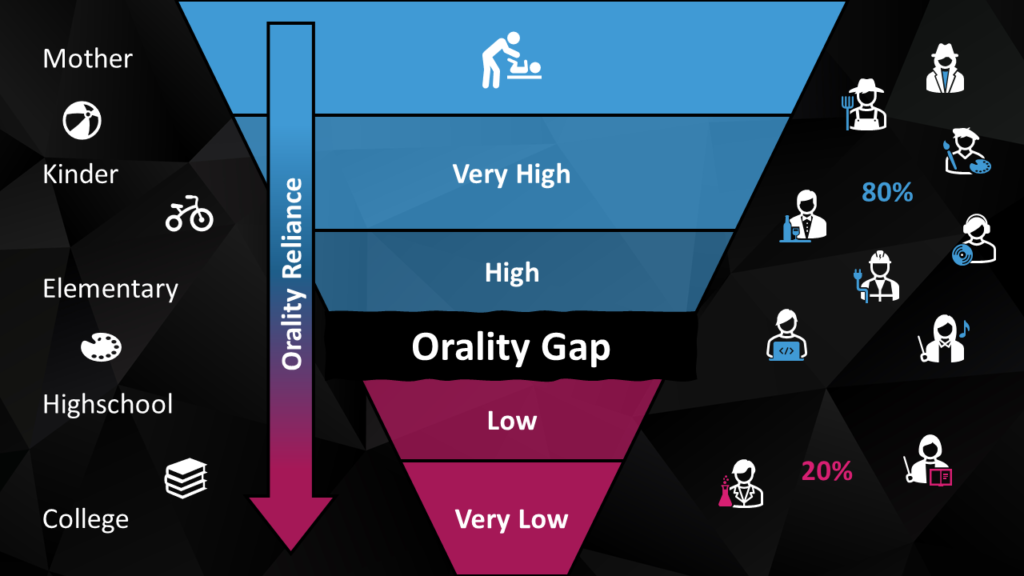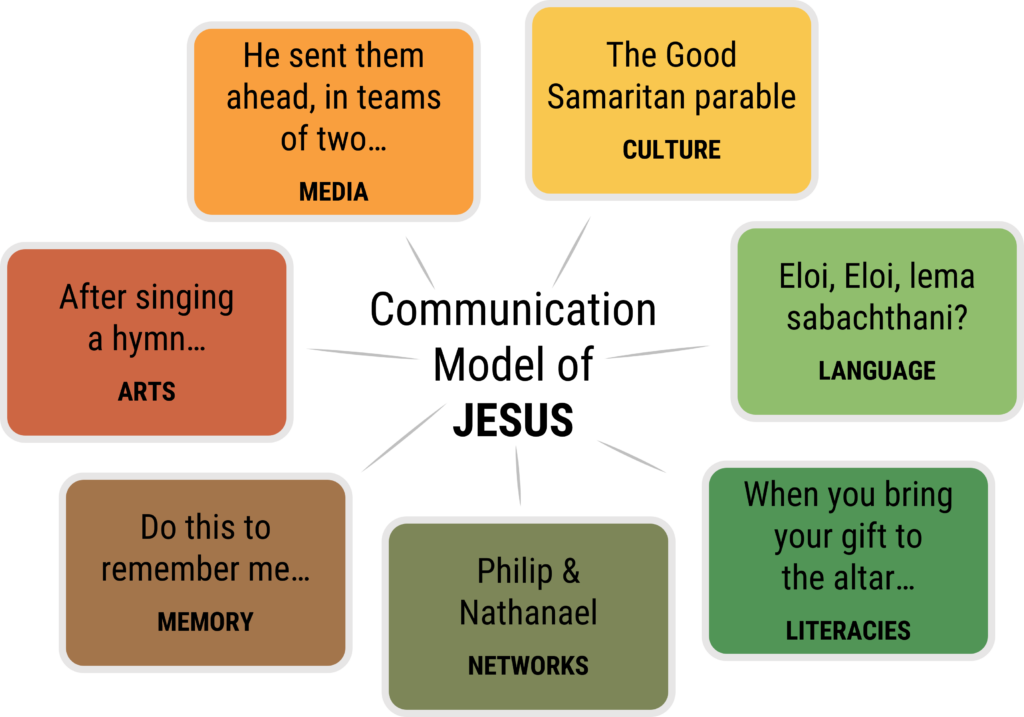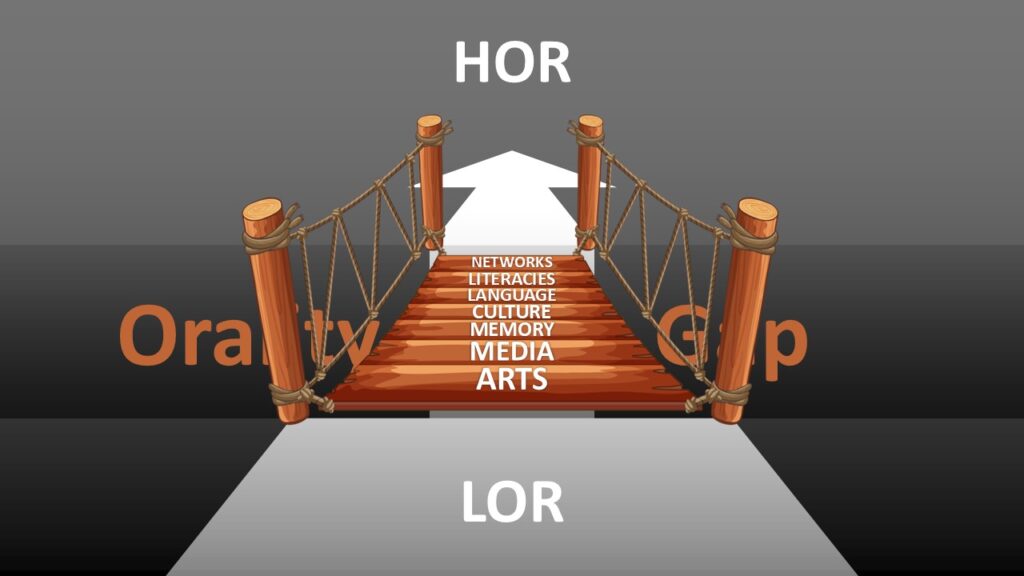Foundations of Orality
Module 1
Explore God’s design for communicating among people created in His image. How can we communicate with higher impact and scale? We will discover how orality affects every aspect of communication.

Lesson 9 – Review & Repetition
This lesson intends to review the entire module 1 and make it more memorable.
Click the arrows for more details.
This box provides general information on how our lessons are structured
The content of this site is hidden at first and meant to be revealed once the previous task is complete to guide you along the learning experience.
This is a resource for you! The lessons can be studied independently, in groups, or as part of the IOS certification program. Use it to learn or to 🚂 train others.
We encourage interaction with the material and with others whenever you encounter these emojis 😃🤔🤯.
This frame indicates a story, example, or case study.
Please leave your observations, findings, and links to additional resources in the 💬 comment section below, as they will benefit others. Enjoy!
Defining Orality
You may be familiar with these contents as most is a repetition but don’t skip it! Repetition is a key ingredient of memory, and this lesson contains some new content.
80% (8 out of every 10 people) of the world’s population depend on and prefer oral communication.1
We are born that way!
Definition of Orality
Learned expressions of inner speech using all senses to receive, process, remember, and pass on truth and information.2
😃🤔🤯 Repeat the definition of orality with the gestures you made up in lesson 1.
Expression of “inner speech”
Orality is all about how we communicate our ❤️hearts and 🧠minds.
😃🤔🤯 Find 6 examples (3 from the Old Testament prophets and 3 from the New Testament Missionaries) of God’s people in the Bible using creative ways of communicating God’s message.
Using all senses
The more sensory a message is, the bigger the chance it “sticks.”

😃🤔🤯 Think of a Bible passage. Imagine how a pastor can use all senses (🫳🏻👂🏻👅👃🏻👁️) to teach about it.
The “how’s?” of orality
Think about receiving, processing, remembering, and passing on as a cycle. Only if people pass on a message, others will hear and the cycle is complete.
Whatever you heard me teach before an audience of witnesses, I want you to pass along to trustworthy people who have the ability to teach others too.
2 Timothy 2:2, VOICE
😃🤔🤯 Describe how you can be more intentional in the generational thinking in your ministry as Paul did.
Challenges for the Oral Majority
The Christian message must not remain something for a dominant minority. It must impact the excluded majority! It must be…
- Reproducible
- Will the unschooled widow be able to share it with her neighbor?
- Can a farmer start a Bible study group among other farmers?
- Behavior change
- Will the message change behavior toward abused/exploited children?
- How will it impact people involved in corrupt practices?
- Scalable
- Does the message have the chance to become viral?
- Can simple people continue to spread the message?
- Educating & evaluating
- Are Bible school and seminary students still connected with the way everyday Christians think?
- How long must someone study to become effective in ministry?
God, an oral communicator
- And God said… (Genesis 1:3)
- …in His own image (Genesis 1:26-27)
- Write down, sing, teach (Deuteronomy 31:19)
- What to say and how to say it (Jonn 12:49)
God is an oral communicator.
So it is when I declare something. My word will go out and not return to Me empty, But it will do what I wanted; it will accomplish what I determined.
Isaiah 55:11, VOICE
Orality Gap
Imagine you live in one of the houses on the mountain on the left side of the picture.
One day, you take your 🚴🏻 to visit your friend in the little town. Overnight, it rained hard in the mountains, and the little creek turned into a river.
😃🤔🤯 Move the slider on the picture below to the right side. What do you need to be able to return home?


The Orality Gap in Education
80% of the world, or 8 out of 10 people, favor oral communication methods like music, arts, and drama over written text.3 The dominance of Western text-centric education standards further widens the gap between oral and text-reliant cultures. The COVID-19 pandemic even widened the gap.4
It is no secret that the higher the academic level of education, the less we rely on orality and the more we focus on written text.

Intentional or not, this creates a gap between pupils and teachers, theological educators and students, pastors and church members.5
😃🤔🤯 Maybe by now, you had more time to ponder and saw more cases of the Orality Gap in your context. Add them to the list of examples you made in lesson 3.
Coding a ❤️
Can you describe a big red heart in the middle of a browser window?
<!DOCTYPE html><html lang="en"><head><meta charset="UTF-8"><meta name="viewport" content="width=device-width,initial-scale=1.0"><title>Heart Emoji</title><style>body,html{height:100%;margin:0;display:flex;justify-content:center;align-items:center;background-color:#f0f0f0;}.heart{font-size:10em;color:red;}</style></head><body><div class="heart">❤</div></body></html>The code above does it, but you cannot understand it unless you know HTML.
😃🤔🤯 Record yourself pondering about the question: “Do people first undergo western (theological) education to fully understand God’s Word?
❤️
What if we used orality and showed people a big red heart instead of giving people the code they can only understand if they know programming?
Bridging the Gap like Jesus
Even in secular circles, Jesus is widely regarded as a master teacher.
😃🤔🤯 List at least 5 Bible passages of Jesus teaching. For each passage you enlisted, describe Jesus’ teaching approach, the audience, and the outcome of His lesson.
The “how” to say it
I don’t speak on my own authority. The Father who sent me has commanded me what to say and how to say it.
John 12:49, NLT
Today, most education, including theological education focuses on the content—on WHAT to say.
While content is king, what is the use if the content can’t be delivered?
Jesus understood HOW to package God’s message in a way, that people understood it clearly. People did not always agree with Jesus but they understood!
Communication model of Jesus
These are 7 distinct communication tools Jesus used to deliver His message and make it stick.

- Culture (Luke 10:25-37)
- Language (Mark 15:34)
- Literacies (Matthew 5:23-24)
- Networks (John 1:43-51)
- Memory (Luke 22:19)
- Arts (Matthew 26:30)
- Media (Luke 10:1)
🗺️
Scroll through these maps of London.
All maps are just partial depictions of reality. Are you a tourist, using the subway, or driving? Each situation calls for a different map as the best guide.
😃🤔🤯 Think about the story of the Lost Coin in Luke 15:8-10. Demonstrate a few different ways of showing God’s joy for one sinner who repents. Integrate as many disciplines of orality as you can.
The 7 Disciplines of Orality
This figure summarizes the entire foundations of orality module.

- The 15 traits of orality allow us to analyze the orality reliance of the people we are working with.
- They inform our communication strategies.
- The 7 disciplines of orality are the packaging for the message.
- The message is God’s ❤️heart and 🧠mind.
- God’s desire is more than just spreading information, it is transformation.
- Transformation will happen when people receive, process, remember, and pass on the Truth in their terms and in ways they understand it best!
😃🤔🤯 For each of the 7 disciplines of orality:
- Find at list one Biblical reference/example.
- What are some traits of orality that closely relate to that discipline?
- Why does it matter to God? How is it relevant in your ministry?
Building bridges
In Exodus 3-4, we can read how God called Moses to free the Israelites from Egypt. Here is one verse of that passage:
Eternal One: What do you have in your hand?
Moses: My shepherd’s staff.
Exodus 4:2, VOICE
What is in your hand? Or better asked: What are the learning preferences of the people we like to reach with the Good News of the Kingdom?

😃🤔🤯 Make a mindmap showing how the 7 disciplines of orality can bridge the gap for the people you are working with.
How can they hear
8 in 10 people in the world cannot hear or understand the message because of OUR preferences and choices.
🎵
Listen to Will You Not Listen? by Michael Card.
90% of Christian education relies on low orality methods.
😃🤔🤯 Record yourself reflecting on this module. Include at least 2 changes that you will implement in your ministry so that others can hear God’s message in a way they understand it best.
Footnotes
- 📃 Grant Lovejoy, “The Extent of Orality: The Word Become Flesh,” Orality Journal, no. The Word Become Flesh (2012): 11–40. ↩︎
- 📃 Charles Madinger, Rocelyn Madinger, and Daniel Ponraj, “Unleashing the Power of Orality,” OralityTalks Journal 1, no. 1 (2024): 19. ↩︎
- 📃 Grant Lovejoy, “The Extent of Orality: The Word Become Flesh,” Orality Journal, no. The Word Become Flesh (2012): 11–40. ↩︎
- 🌐 World Bank, “70% of 10-Year-Olds Now in Learning Poverty, Unable to Read and Understand a Simple Text,” 2022. ↩︎
- 📃 Charles Madinger, “Applications of the Orality Discussion,” Evangelical Missions Quarterly 53, no. 1 (2017): 55. ↩︎
🎉Congratulations, you finished this lesson!
Leave additional resources and ideas for others in the 💬comment section below!
🥳Enjoyed this module? We’d love to hear from you and get to know you. Please 🤙🏻get in touch with us to share your feedback and experience.
All our materials are 🔓open-access. If you found them helpful, consider 💰donating to support our ministry. Thank you!

Leave a Reply